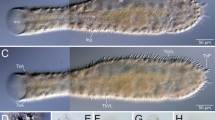Summary
The development of external glands on traps and stolons ofU. monanthos has been studied using transmission electron microscopy. During early differentiation of the epidermis some cells remain narrow and develop a protuberance which subsequently divides into a terminal and a pedestal cell, with the remainder of the original cell forming the basal epidermal cell of the gland. The lateral wall of the pedestal cell soon becomes densely impregnated throughout its thickness, and this is followed by the formation of discontinuous cuticular deposits within the primary wall of the terminal cell. The outer wall of the terminal cell then usually undergoes extensive secondary wall thickening beginning with the formation of ingrowths which for a period characterize the cell as a transfer cell. Later, at the stage when traps begin capturing prey, these ingrowths are overlain by further layers of secondary wall material. Concomitantly, in the pedestal cell, wall ingrowths become fully differentiated on the outer transverse wall and persist throughout the remaining life of the gland.
The function of external glands during early ontogeny is discussed. At the stage when the terminal cell is differentiated as a transfer cell it is suggested that the gland is mainly responsible for absorbing solutes from the external medium. Once traps commence capturing prey the gland may become modified for a rôle in water secretion, facilitated by the differentiation of the pedestal cell as a transfer cell, and by the formation of a thick outer wall in the terminal cell.
Similar content being viewed by others
References
Courtoy, R., Simar, L. J., 1974: Importance of controls for the demonstration of carbohydrates in electron microscopy with the silver methenamine or the thiocarbohydrazide-silver proteinate methods. J. Microscopy100, 199–211.
Czaja, A. Th., 1922: Die Fangvorrichtung der Utriculariablase. Z. Bot.14, 705–729.
—, 1924: Physikalisch-chemische Eigenschaften der Membran der Utriculariablase. Pflüg. Arch. ges. Physiol.206, 554–613.
Diannelidis, T., 1948: Beitrag zur Elektrophysiologie pflanzlicher Drüsen. Phyton1, 7–23.
Fahn, A., Rachmilevitz, T., 1970: Ultrastructure and nectar secretion inLonicera japonica. In: New research in plant anatomy (Robson, N. K. B., Cutter, D. F., eds.), pp. 51–56. London: Academic Press.
Fineran, B. A.,Gilbertson, J. M., 1980: Application of lanthanum and uranyl salts as tracers to demonstrate apoplastic pathways for transport in glands of the carnivorous plantUtricularia monanthos. European J. Cell Biol. (in press).
—,Lee, M. S. L., 1974 a: Transfer cells in traps of the carnivorous plantUtricularia monanthos. J. Ultrastruct. Res.48, 162–166.
—, 1974 b: Ultrastructure of glandular hairs in traps ofUtricularia monanthos. In: 8th Internat. Congr. Electron Microscopy2 (Saunders, J. V., Goodchild, D. J., eds.), pp. 600–601. Canberra: The Australian Academy of Science.
—,Lee, M. S. L., 1975: Organization of quadrifid and bifid hairs in the trap ofUtricularia monanthos. Protoplasma84, 43–70.
— —, 1980: Organization of mature external glands on the trap and other organs of the bladderwortUtricularia monanthos. Protoplasma103, 17–34.
Gunning, B. E. S., 1977: Transfer cells and their roles in transport of solutes in plants. Sci. Prog., Oxf.64, 539–568.
—,Pate, J. S., 1969: “Transfer Cells”. Plant cells with wall ingrowths, specialized in relation to short distance transport of solutes—their occurrence, structure, and development. Protoplasma68, 107–133.
— —, 1974: Transfer cells. In: Dynamic aspects of plant ultrastructure (Robards, A. W., ed.), pp. 441–480. Maidenhead, U.K.: McGraw-Hill.
Kenneth, J. H. (ed.), 1963: Henderson's dictionary of biological terms, 8th edition, 640 pp. Edinburgh-London: Oliver and Boyd.
Kristen, U., 1974: Feinstruktur und Entwicklung der äußeren Fangblasendrüsen vonUtricularia minor L. Cytobiologie9, 321–330.
Kruck, M., 1931: Physiologische und zytologische Studien über die Utriculariablase. Arch. Bot.33, 257–309.
Leutzelburg, P. von, 1910: Beiträge zur Kenntnis der Utricularien. Flora100, 145–212.
Lloyd, F. E., 1935:Utricularia. Biol. Rev.10, 72–110.
Lloyd, F. E., 1942: The carnivorous plants, 352 pp. New York: The Ronald Press Company.
Lüttge, U., 1971: Structure and function of plant glands. Ann. Rev. Plant Physiol.22, 23–44.
Mayr, F. X., 1915: Hydropoten an Wasser- und Sumpfpflanzen. Diss. Erlangen, 1914. Beih. Bot. Centralbl. I,32, 278–371.
Nold, R. H., 1934: Die Funktion der Blase vonUtricularia vulgaris. (Ein Beitrag zur Elektrophysiologie der Drüsenfunktion). Beih. Bot. Zbl.52, 415–448.
Pate, J. S., Gunning, B. E. S., 1972: Transfer cells. Ann. Rev. Plant Physiol.23, 173–196.
Schnepf, E., 1964: Zur Cytologie und Physiologie pflanzlicher Drüsen. 4. Teil. Licht und elektronenmikroskopische Untersuchungen an Septalnektarien. Protoplasma58, 137–171.
—, 1974: Gland cells. In: Dynamic aspects of plant ultrastructure (Robards, A. W., ed.), pp. 331–357. Maidenhead, U.K.: McGraw-Hill.
—,Pross, E., 1976: Differentiation and redifferentiation of a transfer cell: Development of sepal nectaries ofAloe andGasteria. Protoplasma89, 105–115.
Spurr, A. R., 1969: A low viscosity epoxy resin embedding medium for electron microscopy. J. Ultrastruct. Res.26, 31–43.
Sydenham, P. H., Findlay, G. P., 1975: Transport of solutes and water by resetting bladders ofUtricularia. Aust. J. Plant Physiol.2, 335–351.
Thiéry, J. P., 1967: Mise an évidence des polysaccharides sur coupes fines en microscopie électronique. J. Microscopie6, 987–1018.
Author information
Authors and Affiliations
Rights and permissions
About this article
Cite this article
Fineran, B.A. Ontogeny of external glands in the bladderwortUtricularia monanthos . Protoplasma 105, 9–25 (1980). https://doi.org/10.1007/BF01279846
Received:
Accepted:
Issue Date:
DOI: https://doi.org/10.1007/BF01279846




